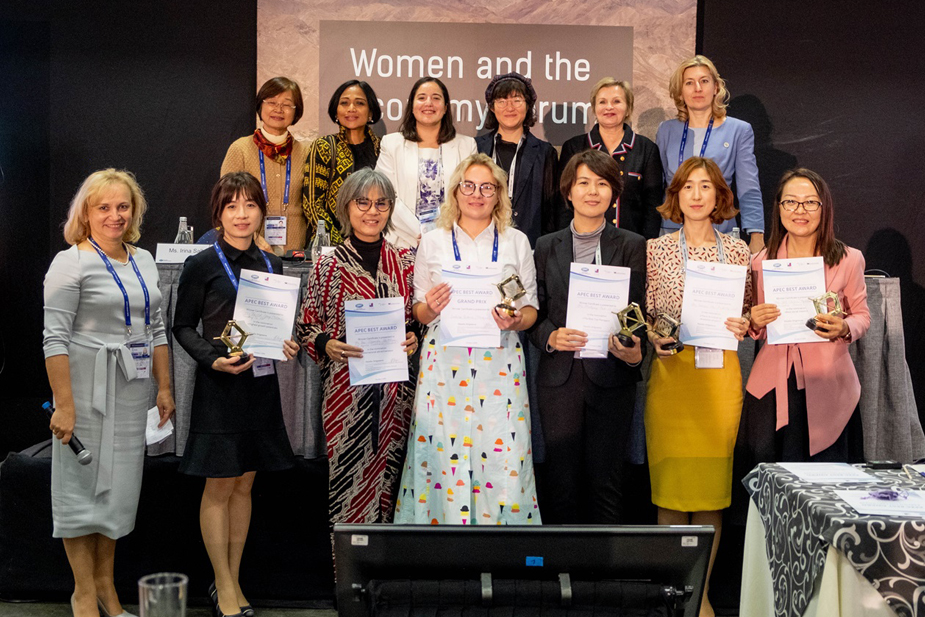Last page update:

Winners of the APEC BEST Awards represent some of the best women-led small businesses in the Asia-Pacific. Women lead many of the region’s small businesses yet face challenges in accessing financing.
By Dr. Rebecca Sta Maria, Executive Director of the APEC Secretariat
In recent weeks, I have been following developments in the global economy while also joining APEC meetings focused on helping the region’s small businesses.
While we should keep a close eye on the evolving economic outlook, the time I spend with hopeful entrepreneurs – whether at APEC SME Week or the APEC Women and the Economy Forum or next week’s Finance Ministers’ Meeting– provides a different reality check.
Yes, the global economic outlook impacts an entrepreneur’s bottom line. But usually the worries of entrepreneurs are more immediate. Consider these typical concerns. How to obtain a loan when the potential collateral is under the name of one’s spouse – or parent. How to receive payments for contracts on time and before the due date of next month’s utilities bills. Or, how to navigate the byzantine menu of procedures for export.
Small businesses, from micro-enterprises to medium-size firms, account for more than 95 percent of APEC economies. Yet they routinely face challenges that can make or break their business. Imagine what our economies can achieve when more of our small businesses thrive.
Chile, APEC host economy for 2019, got it right when they announced this year’s theme as ‘Connecting People, Building the Future’. Connect our small businesses to more markets and global value chains. Connect women entrepreneurs to investors and mentors. Connect our government agencies so that they may simplify regulations that encroach instead of empower.
APEC has carried out many initiatives to help small businesses. The 2015 Boracay Action Agenda includes various efforts to ensure that as economies grow, so do small businesses. Our efforts at trade facilitation have been particularly helpful. International trade can be incredibly daunting to a company with less than ten employees. Two employees alone can be fully occupied with learning the long checklist for exporting.
Technology is the buzzword of today. But all the talk of e-commerce and a digital economy does not eliminate the physical world. A business still has to comply with all the rules and regulations to deliver products and services to markets.
Here, APEC plays a critical role. APEC helps small businesses to understand rules, regulations, standards to meet, and customs procedures. Numerous facilitation mechanisms are in place.
Some economies have systems in place that can fast-track qualified exporters. But becoming ‘qualified’ can be a full-time endeavor in itself. Again, APEC provides capacity building for small businesses so that they can meet the qualifications.
For businesses that prefer an alternative way to grow, APEC also helps companies to tap into the global value chains of larger corporations. There are myriad ways that we assist small and medium enterprises to become ‘international’.
But as someone who spent her career developing and issuing policy, I can vouch that government plays the key role in improving the prospects of a business.
Recently, I joined the launch of the updated APEC Women and the Economy Dashboard, which consists of 95 indicators of women’s capacity for advancement in the economy. While many APEC economies have carried out policy reforms that have improved women’s lives, the dashboard reports, much more can be done.
For example, many women still can’t obtain credit because she is a woman or unmarried. Only 9 out of 21 APEC economies have laws that mandate non-discrimination by creditors based on gender. Only 7 economies prohibit credit discrimination based on marital status.
Given that many small businesses are led by women, these barriers can be crippling.
For these small businesses who drive the growth, innovation and optimism of our communities, the news that matter most are those that ease their day-to-day operations. The changes that matter are those that their governments can deliver.
Let’s change what we can change for the better.

